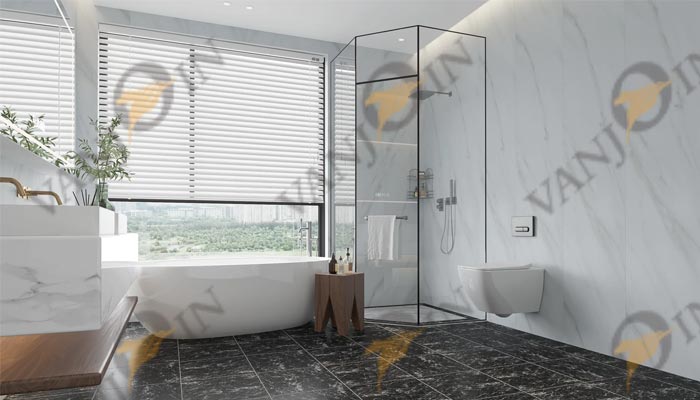Welcome to VANJOIN. Your satisfaction is our biggest pursuit.
With the growing demand for durable, aesthetic, and cost-effective wall paneling, Stone Plastic Composite wall panels (SPC wall panel) have become a popular choice for both residential and commercial spaces. These panels offer exceptional durability, waterproof capabilities, and easy installation, making them a versatile option. However, choosing the right SPC wall panel for your project requires careful consideration of various factors. This guide provides a comprehensive understanding to help you make an informed decision.

1.Understand What SPC Wall Panels Are
SPC wall panels are made from a composite of natural limestone powder, polyvinyl chloride (PVC), and stabilizers. This unique blend ensures a rigid, durable structure that is resistant to wear, moisture, and impact.
Key Features
* Waterproof: Ideal for humid environments like bathrooms and kitchens.
* Durability: Resistant to dents, scratches, and wear.
* Aesthetic Appeal: Available in various textures and colors, including wood and stone finishes.
2.Assess Your Requirements
Consider where you plan to install the panels:
* Residential Spaces: Look for designs that complement your interior style, such as wood grain or marble finishes.
* Commercial Spaces: Opt for panels with higher durability and fire resistance, especially in high-traffic areas.
* Bathrooms and Kitchens: Ensure the panels have excellent waterproof properties and anti-mold features.
Functional Needs
* Sound Insulation: Choose thicker panels for better acoustic performance.
* Thermal Insulation: Look for panels with additional insulation layers if energy efficiency is a concern.
3.Evaluate Material Quality
Thickness
The thickness of SPC panels varies, usually between 4mm to 12mm. Thicker panels offer better durability and sound insulation but may cost more.
Wear Layer
The wear layer protects the surface from scratches and stains. A wear layer thickness of 0.3mm to 0.7mm is standard for most applications. Opt for a thicker wear layer for areas with heavy usage.
Core Stability
Ensure the core material is dense and rigid. A higher stone content in the SPC core provides better stability and less risk of warping over time.
4.Choose the Right Design
Surface Finishes
SPC wall panels are available in various finishes to suit different aesthetics:
* Wood Grain: Ideal for creating a warm, natural look.
* Stone Finish: Perfect for modern and luxurious interiors.
* Abstract Designs: Suitable for artistic and contemporary styles.
Color Coordination
Choose colors that complement your existing décor. Neutral tones are versatile and timeless, while bold patterns can create a statement.
Texture
Panels with embossed textures provide a more realistic feel, especially for wood or stone designs. Smooth finishes, on the other hand, are easier to clean.

5.Consider Durability and Maintenance
Scratch Resistance
If the panels will be installed in high-traffic areas, ensure they have a scratch-resistant coating to maintain their appearance over time.
Stain Resistance
Choose panels with a protective surface layer to resist stains, especially in kitchens and bathrooms.
Cleaning Requirements
Opt for panels with easy-to-clean surfaces. Panels with smooth finishes typically require less effort to maintain compared to textured ones.
6.Check Installation Requirements
Installation Type
* Interlocking Panels: Provide a seamless look and are easy to install.
* Glue-Down Panels: Offer a stronger bond, ideal for areas prone to heavy impacts.
Tools and Skills
If you prefer DIY installation, choose panels with simple interlocking systems. For complex designs or commercial projects, professional installation is recommended.

7.Review Certifications and Standards
Environmental Standards
Look for certifications such as SGS, CE, or FSC that ensure the panels are eco-friendly and safe for indoor use.
Fire Resistance
For commercial buildings, ensure the panels comply with fire safety standards like Class A fire rating.
Formaldehyde Emissions
Choose SPC panels with low or zero formaldehyde emissions to ensure a healthier indoor environment.
8.Compare Prices and Budget
Cost Per Panel
SPC wall panel prices typically range from $3 to $10 per square foot, depending on thickness, design, and brand.
Long-Term Value
While cheaper panels may save costs initially, higher-quality panels often offer better durability and lower maintenance, providing greater value over time.
9.Research Suppliers and Brands
Reputation
Choose a reputable supplier with positive reviews and a strong track record in the industry.
Customization Options
If you have specific design requirements, opt for suppliers that offer customization services.
Warranty
Check the warranty period, which typically ranges from 5 to 20 years. A longer warranty often indicates higher quality.
10.Consider Future Trends
Sustainability
Environmentally friendly panels with recyclable materials are gaining popularity.
Smart Features
Some SPC panels now incorporate smart features like built-in LED lighting or sound-absorbing layers.

Conclusion
Choosing the right SPC wall panel involves careful consideration of your project’s requirements, material quality, design preferences, and budget. By understanding the key features and benefits of SPC panels, assessing your needs, and comparing options, you can select a product that meets your expectations and enhances the functionality and aesthetics of your space. Always collaborate with trusted suppliers and installers to ensure the best results.
Whether for a home, office, or commercial building, SPC wall panels provide a durable, stylish, and practical solution that can transform any space into a masterpiece.
Got a question, comment or business enquiry? We are always happy to hear from you.